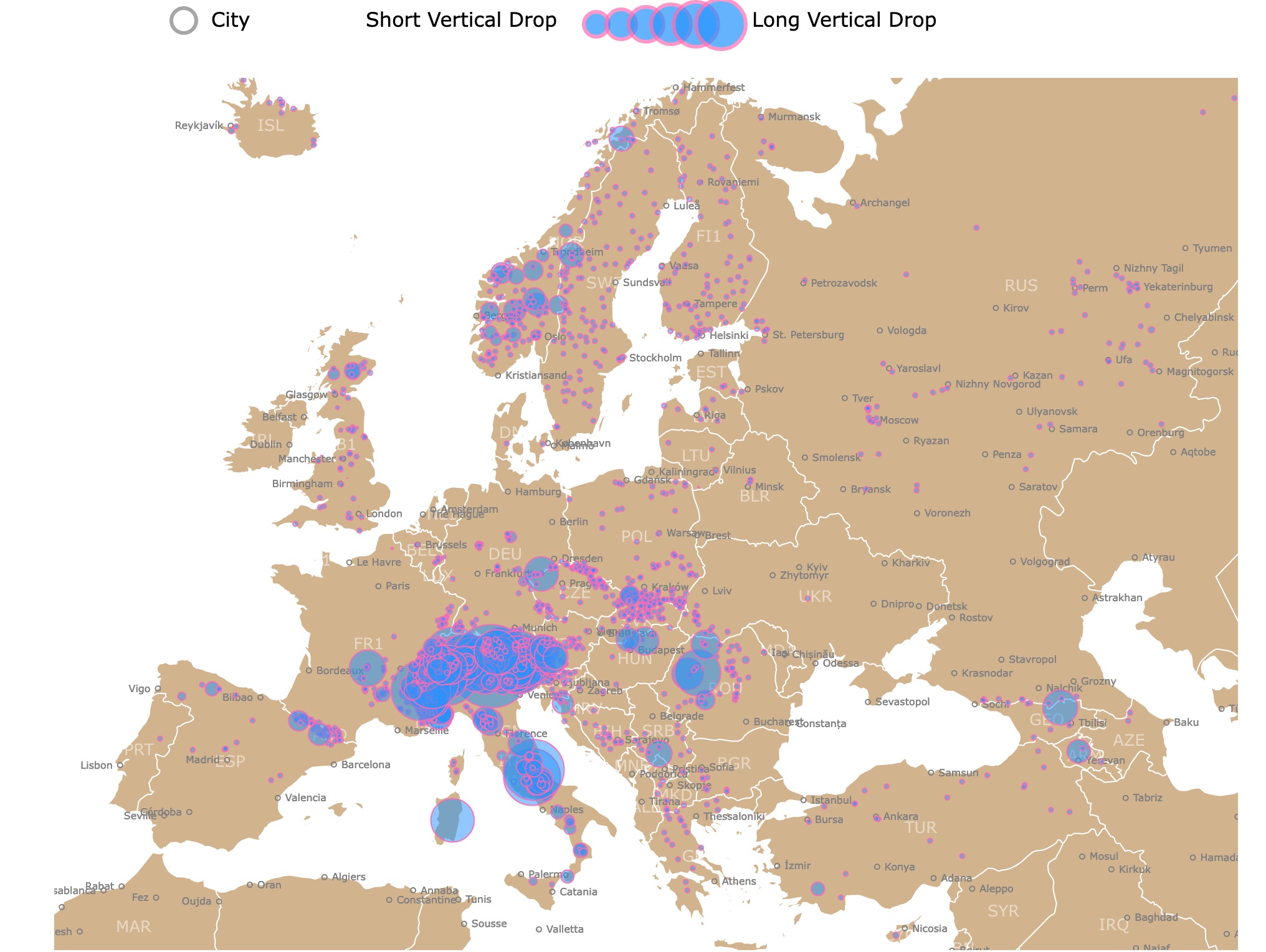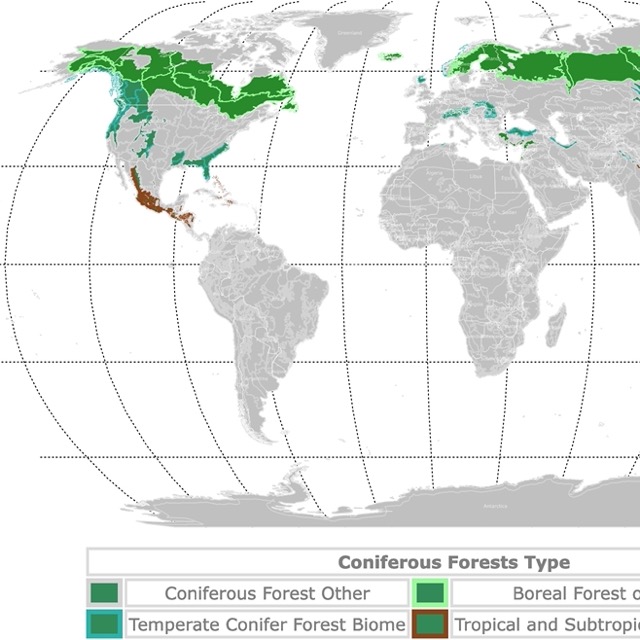Map of Ski Runs in Europe
This is an interactive map of Ski Runs in Europe. It shows the Location, Name, and Websites of Ski Resorts. Larger circles represent a higher descent. Zoom in for more details. Scroll down for more information
European Ski Resorts Map
This map displays skiing resorts in Europe.
Higher descent is the difference between the highest and the lowest point in the resort or run. It does not necessarily mean that a run has that height difference.
The descent might be shared by several runs. But remember, the higher you go, the harder it is to breathe!
This map was created to contrast and complement with the U.S.A. Map Ski Resorts.
For a completely different ski map visit Map of ski areas in Japan.
Ski in Europe
There are many benefits to skiing in Europe, besides the rich local culture and prices.
The best ski resorts in Europe are close neighbors. They form huge, interconnected ski fields—connected by trails, lifts, and shuttles.
If it is a season with little snow, then you can rely on fun skiing on high-altitude glaciers and at snow-sure resorts.
Just remember après-ski was invented in Europe. What is après-ski? The social activities and entertainment following a day's skiing. Source: On the Snow.
Remember skiing is not limited to the Alps. Scandinavian countries and Eastern Europe are alternatives highlighted on the map.
If you want to check prices and dates for some of these destinations this Expedia widget can help.
Skiing in France
Skiing in France is usually characterized by two things: Skiing at a very high altitude and skiing at huge, often cosmopolitan, ski resorts.
Chamonix, France
Known for its challenging off-piste terrain and the famous Vallée Blanche, Chamonix is a mecca for experienced skiers and snowboarders.
Chamonix typically receives a significant amount of snowfall during the winter season, with an average of around 5 to 8 meters (16 to 26 feet) of snow.
Chamonix is known for its demanding terrain, including the famous Vallée Blanche off-piste descent, which is one of the longest ski runs in the world, stretching for over 20 kilometers (12 miles) from the Aiguille du Midi to Chamonix town.
Chamonix is by far the biggest and most cosmopolitan. It offers restaurants, pubs, concerts, clubs, spas, gyms, and shopping.
For an unforgettable experience in Chamonix, Le Hameau Albert 1er, is a winter wonderland with a full-service spa. Find the details on Expedia!
Val d'Isère/Tignes, France
Val d'Isère and Tignes together form the vast Espace Killy ski area, offering a diverse range of slopes and reliable snow conditions.
These two resorts offer over 300 kilometers (186 miles) of ski runs, including the famous La Face de Bellevarde, a challenging Olympic downhill run.
Val d'Isère and Tignes have an average snowfall of approximately 4 to 7 meters (13 to 23 feet) during the winter season. This is thanks to its 2,100 meters/6,900 feet in altitude.
To find your dream stay at Val d'Isère go to Hotels.com.
Courchevel, France
Courchevel offers a mix of beginner-friendly slopes and challenging terrain, along with luxury accommodations and fine dining.
Courchevel benefits from a good amount of snowfall, with an average of around 4 to 6 meters (13 to 20 feet) of snow during the winter.
Courchevel offers over 600 kilometers (372 miles) of ski runs, including a wide range of slopes for all levels of skiers.
Why choose a regular hotel when you can stay in a studio or chalet? For more information visit VRBO.
The Three Valleys, Les 3 Vallées’, French Alps
The Three Valleys is a vast ski area that links many different resorts and villages.
You can ski at 7 different main ski resorts including Courchevel, La Tania, Meribel, Val Thorens, St. Martin de Belleville, and Orelle.
La Grave, France
La Grave is renowned for its extreme off-piste skiing and is a destination for experienced skiers looking for a backcountry adventure.
La Grave is known for its deep snowpack, with an average snowfall of approximately 4 to 7 meters (13 to 23 feet) during the winter season.
La Grave does not have marked runs in the traditional sense. Skiers come here for the challenging and unpatrolled terrain, with descents tailored to their abilities and preferences.
Paradiski
Paradiski is a ski area in the Tarentaise Valley of France that offers uninterrupted skiing in between the areas of Les Arcs, Peisey-Vallandry, and La Plagne.
Skiing in Switzerland
Switzerland encompasses different groups of peoples and languages in one single country, Switzerland is among the most diverse alpine winter sports destinations.
Besides its diversity, it is worth mentioning that Swiss resorts are generally much more expensive for food and beer.
Zermatt, Switzerland
Home to the iconic Matterhorn, Zermatt offers high-altitude skiing with stunning views and a charming, car-free village.
Zermatt is known for its reliable snow conditions, with an average snowfall of around 4 to 5 meters (13 to 16 feet) during the winter months.
Zermatt offers a variety of ski runs, including the famous Matterhorn Glacier Paradise, with runs that can be as long as 25 kilometers (15.5 miles) from the Klein Matterhorn to Zermatt village.
For a stay with amazing views of the Matterhorn, Expedia can help. Just Click HERE!
Andermatt, Switzerland
Andermatt has gained popularity in recent years for its off-piste terrain and the development of a new ski area linked with Sedrun.
Andermatt receives a generous amount of snowfall, with an average of around 5 to 7 meters (16 to 23 feet) during the winter months.
Andermatt offers a mix of ski runs, including challenging off-piste descents and the Gemsstock area, known for its steep and demanding terrain.
Verbier, Switzerland
Verbier is part of the extensive 4 Vallées ski area and is known for its challenging terrain, vibrant nightlife, and stunning views of the Swiss Alps.
Verbier enjoys a good amount of snowfall, with an average of around 3 to 5 meters (10 to 16 feet) of snow during the winter.
Verbier is known for its extensive off-piste terrain and the famous Tortin run, a challenging off-piste descent, which offers over 400 kilometers (248 miles) of ski runs.
To learn more about ski runs Amazon has 100 Slopes of a Lifetime: The World's Ultimate Ski and Snowboard Destinations. This book is divided by interest and skill level: cross-country routes to intermediate downhill moguls to expert-only backcountry terrain, skiers and snowboarders will find the perfect destination for their dream terrain.
Skiing in Austria
Austria has some of the largest and best ski resorts in Europe. Its most popular skiing region is Tyrol, with 3,500 kilometers of slopes and its world-famous resorts such as Soelden, Ischgl, and St. Anton.
The concept of après-ski started in Austria.
St. Anton, Austria
St. Anton is famous for its lively après-ski scene and varied terrain, including challenging off-piste runs and groomed slopes.
St. Anton receives an average snowfall of approximately 4 to 7 meters (13 to 23 feet) throughout the winter season.
St. Anton is part of the extensive Arlberg ski area, offering over 300 kilometers (186 miles) of ski runs, including challenging off-piste descents and the famous Valluga ski area.
Kitzbühel, Austria
Kitzbühel is famous for its Hahnenkamm downhill race and offers a mix of challenging slopes and picturesque alpine scenery.
Kitzbühel receives an average snowfall of approximately 2 to 4 meters (7 to 13 feet) throughout the winter season.
Kitzbühel is known for its varied ski terrain, including the famous Streif downhill race course, one of the most challenging and iconic runs in the world.
Skiing in Italy
In general, Italy can be more reasonably priced than other Europe ski destinations.
Italy is also the stronghold of heli-skiing across the Alps. It has Europe's best variety, best value, and highest number of heliskiing operators and locations.
What is Heli skiing? Heli-skiing is off-trail, downhill skiing or snowboarding where the skier reaches the top of the mountain by helicopter, instead of a ski lift.
Cortina d'Ampezzo, Italy
Cortina is known for its beautiful scenery, diverse ski terrain, and the famous Olympia delle Tofane women's downhill course.
Cortina typically receives a moderate amount of snowfall, with an average of around 3 to 4 meters (10 to 13 feet) during the winter months.
The Dolomites
The Dolomites also known as the Dolomite Mountains, Dolomite Alps or Dolomitic Alps, are a mountain range in northeastern Italy.
Comprising 16 ski areas and 12 ski resorts and a total of 1,246 km of slopes, it is one of the largest ski areas in the world.
The ski areas include Cortina d'Ampezzo, Plan de Corones/Kronplatz, Alta Badia, Val Gardena/Gröden, Alpe di Siusi/Seiser Alm, Val di Fassa, Carezza, Arabba, Marmolada, Tre Cime, Val di Fiemme, Obereggen, San Martino di Castrozza – Rolle Pass, Rio Pusteria – Bressanone/Brixen, Alpe Lusia – San Pellegrino, and Civetta.
Climate Change and Ski in Europe
Ski tourism plays a significant role in Europe's tourism industry. Nevertheless, higher temperatures, have resulted in lower snow cover across European slopes.
To compensate, resorts have turned to artificial snowmaking to adapt. However, the effectiveness of snowmaking is highly variable and its use is controversial in mountain areas.
Europe is the world’s largest ski market, with around 50% of the world’s total ski resorts.
To learn more about this issue check this article by the Carbon Brief.
Resources for Ski Resorts in North America Map
The ski resort's data, names, location, run type, and elevation were downloaded from Skimap.org.
The Shapefiles for this map were downloaded from Natural Earth. The code was obtained and altered from Chris Williams’s Block.
Made by Luz K. Molina with D3.js.
This map will be updated with improved and recent information! To receive updates on this and more nature maps, join my email list!!!!!!!







